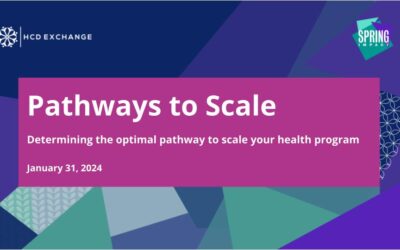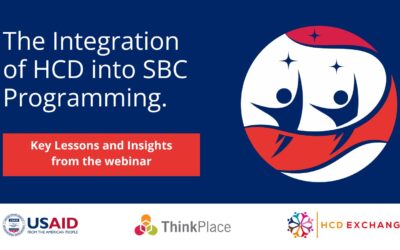In March this year, the HCDExchange launched a Design Fellowship programme that matched young designers with organisations focused on adolescent sexual reproductive health to support their initiatives and stimulate the adoption of HCD methodologies in ASRH as well as drive cross learning between emerging human-centred design professionals. The inaugural Fellows are Susan Towett who worked with Grassroot Soccer, David Mireri who worked with PS Kenya/A360 and Nzisa Kioko who worked with YLabs.
With the Fellowship now complete, the November Community Call was dedicated to hearing how the fellows have worked with the host organisations to integrate HCD methodologies in their programming and what they have learned in the process.
Panelists
The conversation was guided by two of the Fellows and two representatives from the host organisations. They were:
- Susan Towett: Design Fellow, Grassroot Soccer
- Devyn Lee: Research Officer, Grassroot Soccer
- David Mireri: Design Fellow, PS Kenya/A360
- Nancy Njoki: Senior Manager, PS Kenya/A360
- Liz McNeil (Moderator): Senior Community Manager, HCDExchange
Organisational profiles
- PS Kenya runs a Reproductive Health/Family Planning programme aimed at increasing the modern Contraceptive Prevalence Rate in Kenya. It employs cutting edge health interventions to address unmet reproductive health needs and disparities across Kenya and to give women and families at large the power to decide when they would want to have children, how many and how much time they would want in between one child and another.
- A360 Amplify is a five-year project funded by Children Investments Fund Foundation (CIFF) and implemented by Population Services Kenya (PS Kenya) as a sub-award from Population Services International (PSI).
- The Adolescents A360 Amplify, is a user-centric Adolescents, Sexual Reproductive Health (ASRH) project targeting older and married adolescents (15 – 19 years). A360 Amplify aims to assess how A360’s adolescent global user journey can be replicated in Kenya, while retaining its core effectiveness by contextualising A360’s existing interventions in other countries to the Kenyan context. The programme is being implemented in Kilifi, Kajiado, Narok, Migori and Homabay counties under a campaign dubbed Binti Shupavu.
- Grassroot Soccer (GRS) is an adolescent health organisation that uses soccer-based programmes to build the SRHR assets of adolescents, increase their access to health services, and improve their adherence to healthy behaviours and medical treatment
Here are some excerpts from the conversation
On how HCD has changed the way host organisations approach ASRH programming
Nancy (PS Kenya/A360)
- HCD has brought about process improvement. We had been doing a bit of HCD with some shortcuts before, but working with David has helped to improve our way of doing it. I have also been able to nurture my HCD skills by going deeper into each of the phases.
- We have had to have meaningful adolescent and youth engagement as a key strategy evolving within this HCD process because we recognise that youth voices have to be involved in the design. We’ve therefore introduced a Young Innovation Champions programme in every county where the project is.
Devyn (Grassroot Soccer)
- Using HCD more often at GRS, helped to identify that we have used elements of the design process in the past but we have now formalised it.
- Additionally, on the internal organisational level, so many more people understand the value of HCD as the result of hosting a Fellow. Susan has even extended the time of working with GRS as a result of this.
On how working on an ASRH project has changed thinking around individual design practice, or approach to design
David (PS Kenya/A360)
The holistic approach of the intersection between HCD+ASRH is very important, and has enabled me to understand the relevance of incorporating other programmatic components into the project. For example, as much as this intervention is very targeted to the adolescent girls aged between 15-19 years, we had to consider factors like creating an enabling environment through gender inclusiveness, adapting a digital approach in a very strategic manner, integrating economic empowerment, and thinking about the sustainability model review in collaboration with the Ministry of Health.
All those components have to be considered as we move along the HCD process. Initially I had the idea that landscape mapping is sufficient. I was thinking about the layout and availability of facilities and resources that are on the ground. Like – How many health centres are there? Are there many service providers available? Are they trained to be competent enough and offer user friendly service? But now I’ve realised there are other components to the project that one has to consider. So when you’re doing these HCD processes, it’s important to factor all these other components as you go along in order to create holistic products and services that talk to a broad number of users and stakeholders. Essentially, this allows you to bake-in scalability by making the solution ‘fit-for-purpose’ for other entities.
Susan (Grassroot Soccer)
What stands out to me the most within the HCD+ASRH field is that it is important to be an advocate for meaningful youth engagement. At GRS, MYE happens during project proposal, programme design, implementation and evaluation stages.
For example, in a project proposal you focus on problem framing, situational analysis, audience analysis. At this stage, we focus heavily on defining the problem, understanding end-user pain points, and building consensus around project objectives. To do this effectively we may have a collaborative workshop with adolescents and/or Coaches and other project stakeholders in order to get their input prior to a proposal being submitted
The same goes for programme design and implementation stages. Therefore, you must consider how to meaningfully engage the youth and have their voices included in the overall programme design from the very beginning till the end of the project. And this meaningful youth engagement was missing from the other projects I was involved in.
On the challenges faced in integrating HCD methodologies in ASRH programming
Susan (Grassroot Soccer)
Sometimes due to limited resources you might not be able to gather a large number of participants to give input during target audience analysis. So in such a case, it is helpful to include other stakeholders such as community health workers or people who have had extensive experience working with the youth.
These people go from house to house and because they are used to doing SRH activities in the community, are well known by the community. Even the young people know and talk to them, and so you know that they understand what’s happening on the ground. They also know what makes young people open up and talk comfortably, the best practices to converse with the youth in that region, and how easy or difficult it is to have a conversation with a healthcare clinical personnel for a young person at the hospital. If there is judgement involved you also learn how they navigate through it. That experience is really really good to have in the room.
On the value-add of integrating HCD into ASRH programmes
Susan (Grassroot Soccer)
- You are able to understand the target audience needs and challenges and articulate how to solve these issues when submitting a project proposal or even in programme design.
- You are able to get buy-in from project stakeholders during a stakeholder engagement workshop.
- You can build new products/services with confidence given the use of the fail fast strategy whereby you can rapidly design and test ideas relatively quickly with end-users thus avoiding spending a lot of money to fix things at the implementation stage.
Devyn (Grassroot Soccer)
In addition to what Susan has said, I would also add that GRS team members are beginning to see the value-add of formalising the language we use around participatory design processes as HCD.
David (PS Kenya/A360)
One of the major value adds is the replicability of the process for other ongoing/upcoming ASRH projects, for example support for Binti Biashara, we pegged on process learnings from Binti Shupavu.
Nancy (PS Kenya/A360)
Closely related to that is that the documentation of the learning that comes with this process has been helpful. We have very detailed playbooks that have been exciting to work on. We’ve created assets and insights that guide decisions phase by phase, and a great reference towards our wider knowledge management and even learning agenda.
On advice for someone who is approaching ASRH projects for the first time as a designer
Susan (Grassroot Soccer)
Advocate for MYE and getting an understanding of when to measure and what to measure in the context of HCD in ASRH is very critical.
David (PS Kenya/A360)
HCD is a solution-finding approach where you encounter imperfect information as you interact with the users in the various phases, and therefore, a lot of iteration facilitated by proper tooling is important to enable you to understand the qualitative information. Ideate, test and iterate as you zone-in to the actual solution you are looking for.
Additionally, HCD may appear to be a fuzzy process and the best mind set one should have is to be explorative, curious and open minded. Seek to empathize and understand the real needs. Fall in love with problem – not the solution. Also, experiment continuously through rapid prototyping (test – fail / win – learn – test again). Lastly, collaboration is important. Talking to and involving a broad number of users and stakeholders is important as it allows you to bake-in scalability by making the solution “fit for purpose” to other entities to adopt.
On advice for someone who is considering bringing design into their ASRH project for the first time?
Nancy (PS Kenya/A360)
It takes a lot to truly get it right on the solution with the end user. You need expertise, resources, time, tools, but trust the process, it will get you there, with all smiles.
Devyn (Grassroot Soccer)
Start small, give yourself more time than you think you need, and trust that the process will be as rewarding and interesting as the eventual outcomes!



